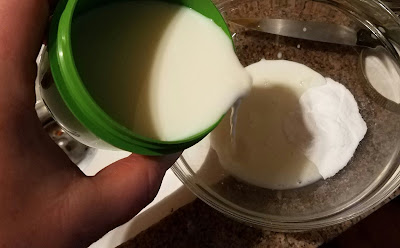I'm becoming a pro at photographing brown food, don'tcha think? Anyway, it's super simple, like Sunday suppers of yore. I grew up with a mish-mash of lucky New Year's foods, with pork and sauerkraut from Mom's family and black-eyed peas from the African American neighbors who helped nurture me when I was very young. From what I've read, this is eaten on New Year's Eve in Germany, but on New Year's Day in German American communities. The Lancaster County, Pennsylvania news website has a nice long list of church and fire hall fundraisers where you can get your good luck meal, but those of us in other parts of the country will need to make our own luck 😊. This should make about 6 servings and take about an hour total. The apple will balance the salty sour cabbage and make for a lovely yet simple meal.
Ingredients:
- a roughly 2.5 pound pork loin (note: not the tenderloin, which is smaller)
- 1 Tbsp each olive oil and butter
- one onion or a couple of shallots
- one apple
- one pound jar plain sauerkraut (not one of the fancy flavors in the refrigerated section)
- 1/4 to 1/2 tsp caraway seeds (if the kraut doesn't have them already)
- salt, pepper, and granulated garlic
- 2 c liquid: dry white wine, beer, broth or water. I used water with 1/4 c white wine vinegar.
Directions:
- Sprinkle a generous amount of salt, pepper and granulated garlic over the pork loin. If you can, do this a few hours or a day ahead.
- Turn on the saute or brown function on your electric pressure cooker. Add oil and butter. Let it heat up until it's hot enough for searing--you don't want to put the meat in too early because the piece is pretty big, and the temperature will drop too much for good browning if you do.
- Let pork sit and brown for at least 5 minutes before you try to turn it to brown the other sides. If it sticks when you try to lift it, leave it until it releases easily.
- In the meantime, mince the onion or shallot (tiny bits) and dice the apple (small cubes).
- Drain the sauerkraut. If you're very salt-sensitive or don't care for the flavor much, you can also rinse it.
- When the pork is browned on all sides, remove it from the pot and toss in the onion or shallots. Stir.
- Once the onion/shallots are soft (just a couple of minutes), add the liquid and use a wooden spoon or silicone spatula to scrape up the yummy brown stuff from the bottom. Stir for another minute.
- Add apples and kraut to the pot and lay the pork loin on top. Lock the lid and set the cooker on high for 15-20 minutes (I did 20 and it was a bit dry, but if your loin is over 2.5 lbs you might want to err on that side. Next year I try 15 and update).
- Once the pressure cooker has finished coming to pressure and cooking, allow 10 minutes of natural release time before you release the rest of the pressure. CAREFULLY release what's left in there and remove the pork and kraut from the pot. Serve over your mash of choice: cauliflower, white bean, or (non-AH) potatoes. Enjoy the good luck all year!










